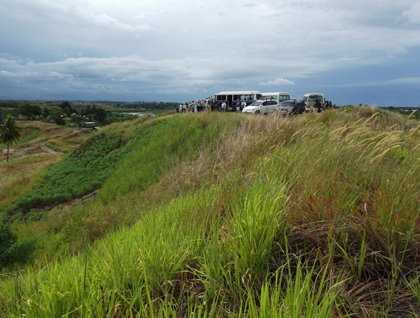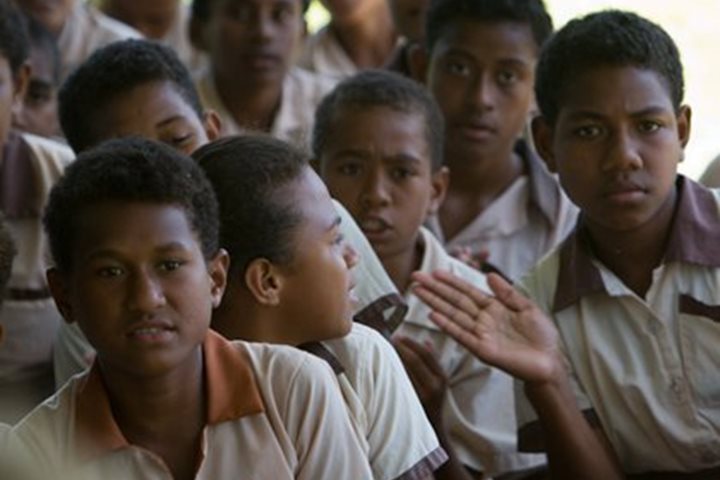As we were at sea this morning among the Solomon Islands Archipelago, it proved an ideal time and place to observe America’s Veteran’s Day. At the 11th hour of the 11th day of the 11th month, while sailing in Iron Bottom Sound, we paid tribute to all Allied war veterans. Onboard were several veterans, including ex-servicemen from U.S., Australian, and New Zealand armed forces. One of these veterans actually served in the U.S. military here on Guadalcanal in 1943. After some words and a moment of silence, a wreath was tossed into the waters of Iron Bottom Sound, so named for the many war ships, including those belonging to Japanese, American, and Australian combatants that now rest on the bottom.
By lunchtime, we were berthed in Honiara, the main city of Guadalcanal and capital of the Solomon Islands. The name “Guadalcanal” is still ingrained into the American psyche, and it brings to mind associated place names such as Bloody Ridge, Red Beach, Henderson Field, and of course, Iron Bottom Sound. The fight for the island was a pivotal engagement during the War in the Pacific, and it played a key role in forcing the Japanese offensive war machine to adopt a strictly defensive strategy. The Japanese 1942 invasion of New Guinea was planned to cross the Kokoda Track on the eastern peninsula and take the strategic harbor of Port Moresby, thereby allowing the Japanese to try to cut off Australia from its allies. The American invasion of Guadalcanal on August 7, 1942, caused the Japanese military command to call back the troops on New Guinea virtually within sight of Port Moresby in order to concentrate their efforts in retaking Guadalcanal. In addition to the terrible fighting on the island, there were six major naval engagements in the surrounding waters, including the Battle of Savo Island, which occurred during the night of the day after the U.S. invasion and gave the U.S. Navy its worst defeat in history. During the next six months, there was almost continuous give and take between Japanese and American forces on shore. It really could have gone either way. Japanese ships brought soldiers and equipment ashore during nighttime via what became known as the Tokyo Express, while the American Marines were essentially stranded for the first couple months unable to take on sufficient supplies from outside sources. Eventually, a war of attrition wore down the Japanese resources of ships, arms, and men, and they evacuated the island in February, 1943. Fighting continued throughout the rest of the Solomon Islands well into 1943, much of it conducted by naval vessels and aircraft. There were 14 major naval engagements within this archipelago during that time, resulting in staggering losses to both sides.
Our time ashore was devoted to several activities, but most people opted for a tour to the some of the important war sites. This included a visit to the impressive American War Monument, which consists of beautiful red granite vertical slabs with detailed accounts of the entire 6 month-long fight for control of the island. We also visited famous Bloody Ridge, where much of the fighting was concentrated to control the strategic air field. While standing on Ridge Number 2, admiring the beautiful and tranquil scenery in all directions, it was very difficult to imagine the horrors of what occurred here 72 years ago. The tour also passed by Henderson Field, the all-important air strip begun by the Japanese, but completed and controlled by the Americans. A small museum/art shop was interesting in that it offered up for sale some excellent wooden art objects and displayed some interesting war memorabilia, including a couple Allied war planes and various tracked vehicles and mobile guns.
Others among us went on a nature excursion in order to do a bit of walking and bird watching in search of some of the interesting exotic and endemic species found here. In addition, a small group of SCUBA divers explored a Japanese shipwreck that was run up on the beach to deliver supplies, but was found and destroyed before it could get off the beach and escape. The shore here is very steep and even thought the bow of the vessel is on the beach, its stern (which is now covered with corals and is home to countless fish) sits in 55 meters (180 feet) of water.
We sailed away from Guadalcanal in the early evening, and watched the lush, green island grow dark as lights delineated the town of Honiara in the distance.







